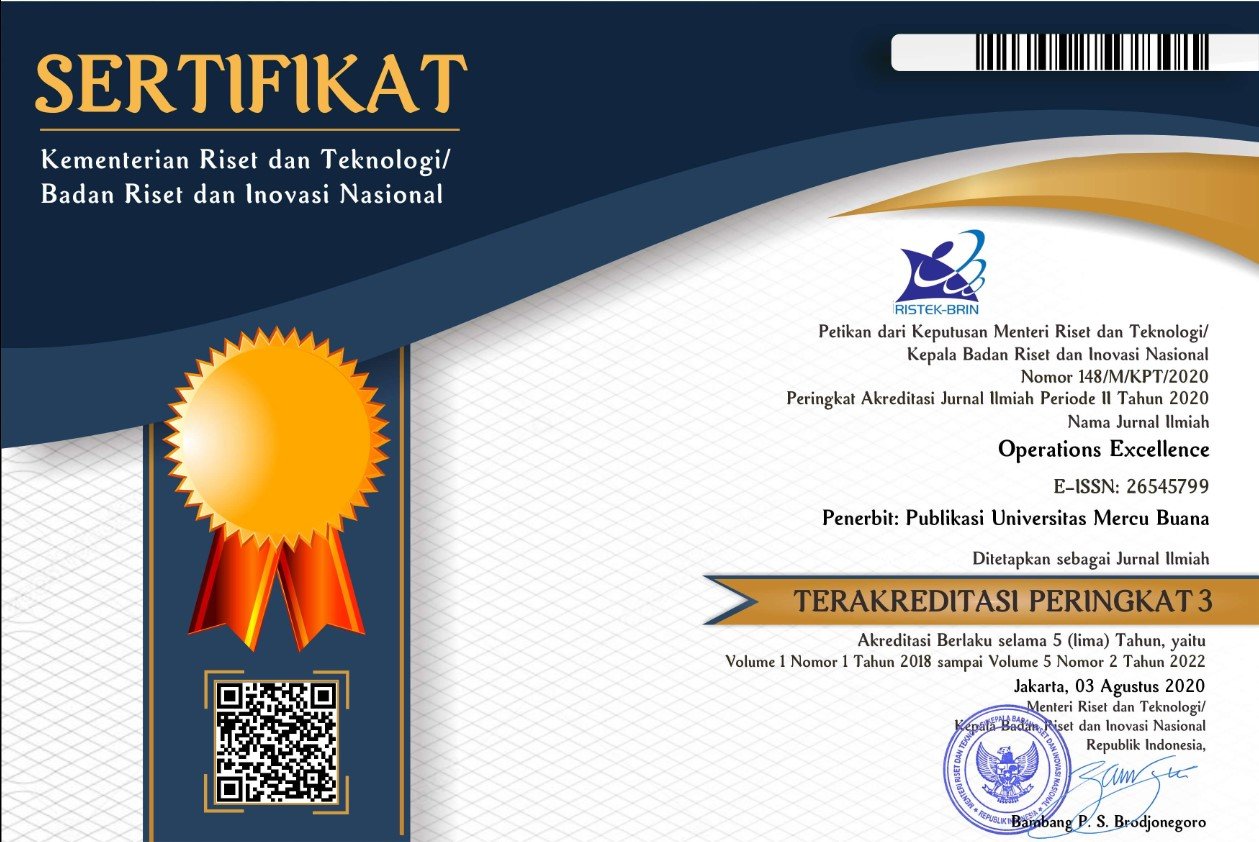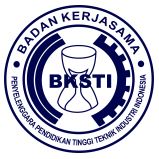Integration of FMEA and TOPSIS for OHS Risk Mitigation Strategy in Lathe Machining Activities : Case Study in PT. SPPA
Abstract
The machining process in PT. SPPA is still carried out conventionally, especially in the idler rebuilding process. There are found work accidents that result in work-related illnesses. In preventing accidents, it is necessary to do risk management efforts. Therefore it is necessary to conduct research by integrating FMEA and TOPSIS for risk management strategies in Occupational Health and Safety (OHS). The FMEA method is used to identify risks and assess the level of risk based on severity, ooccurrence and detection. Furthermore, the TOPSIS method is used to determine the order of priority for improvement to overcome existing risks. The results showed that there were 17 risks in machining activities with a lathe where the risks with the highest RPN value were experiencing pain or muscle cramps when setting up the lathe, experiencing noise during the lathe process, and exposure to chips from the lathe process. Furthermore, each risk is investigated using the 5 Whys method to determine the root causes of the problems, and it was found that the causes of these risks were low-quality work equipment, lack of training, socialization or briefings on OHS, and the high cost of providing adequate PPE. Based on these issues, a priority list of recommendations for improvement is compiled using the TOPSIS method, including routine equipment condition checks, providing SOPs for equipment use, providing appropriate PPE for each job, providing training for employees, allowing adequate rest time, and providing high-quality work equipment.
Keywords
Full Text:
PDFReferences
Aprianto, T., Setiawan, I., & Purba, H. H. (2021). Implementasi metode Failure Mode and Effect Analysis pada Industri di Asia – Kajian Literatur. Jurnal Manajemen & Teknik Industri – Produksi, 21(2), 165–174. https://doi.org/10.350587/Matrik.v21i2.2084
Batson, R. G. (2021). The Role of Maintenance in Reducing the Risk of Technological Disasters. Journal of Civil Engineering Research & Technology, 3(2), 1–7. https://doi.org/10.47363/JCERT/2021(3)118
Fan, C. K., & Cheng, S. W. (2009). Using Analytic Hierarchy Process Method and Technique for Order Preference by Similarity to Ideal Solution to Evaluate Curriculum in Department of Risk Management and Insurance. Journal of Social Sciences, 19(1), 1–8. https://doi.org/10.1080/09718923.2009.11892684
Hendri, H. (2020). Usulan keamanan mesin winding horizontal dengan metode Risk Reduction Management: Studi kasus di PT. XYZ. Operations Excellence: Journal of Applied Industrial Engineering, 12(1), 55. https://doi.org/10.22441/oe.2020.v12.i1.005
Husna, I. E., Azise, A., & Sarifuddin. (2020). The Use of Personal Protective Equipment for Reducing Accidental Risk on Board. Proceedings of the 2nd International Symposium on Transportation Studies in Developing Countries (ISTSDC 2019). 2nd International Symposium on Transportation Studies in Developing Countries (ISTSDC 2019), Kendari, Southeast Sulawesi, Indonesia. https://doi.org/10.2991/aer.k.200220.031
Husni, L. (2019). Pengantar Hukum Ketenagakerjaan Edisi Revisi—Lalu Husni. PT. Raja Grafindo Immawan, T., Sutrisno, W., & Rachman, A. K. (2018). Operational risk analysis with Fuzzy FMEA (Failure Mode and Effect Analysis) approach-Case study : Optimus Creative Bandung. MATEC Web of Conferences, 01084. https://doi.org/https://doi.org/10.1051/matecconf/201815401084
Immawan, T., Sutrisno, W., & Rachman, A. K. (2018). Operational risk analysis with Fuzzy FMEA ( Failure Mode and Effect Analysis ) approach ( Case study : Optimus Creative Bandung ). MATEC Web of Conferences, 01084. https://doi.org/https://doi.org/10.1051/matecconf/201815401084
Kurniasih, D.L. (2013). Sistem Pendukung Keputusan Pemilihan Laptop dengan Metode TOPSIS. Pelita Informatika Budi Darma, III.
Kusumadewi, S., Hartati, S., Harjoko, A., & Wardoyo, R. (2006). Fuzzy multi-attribute decision making (fuzzy madm). Yogyakarta: Graha Ilmu, 74
Mathews, S. C., Stoll, R. A., Sternberger, W. I., Cox, P. W., Tober, T. L., Di Mattina, J., Dwyer, C., Barasch, N., Carolan, H., Romig, M., Pronovost, P. J., Barnes, J. F., Ravitz, A. D., & Sapirstein, A. (2020). Prioritizing Health Care Solutions for Pressure Ulcers Using the Quality Function Deployment Process. American Journal of Medical Quality, 35(3), 197–204. https://doi.org/10.1177/1062860619869990
Matthews, J. C., Piratla, K., & Koo, D. D. (2016). Sustainability evaluation of pipe asset management strategies. Procedia Engineering, 145, 483–490. https://doi.org/10.1016/j.proeng.2016.04.025
Mutlu, N. G., & Altuntas, S. (2019). Risk analysis for occupational safety and health in the textile industry: Integration of FMEA, FTA, and BIFPET methods. International Journal of Industrial Ergonomics, 72(May), 222–240. https://doi.org/10.1016/j.ergon.2019.05.013
Occupational Safety and Health Administration. (n.d.). Introduction to Lathe (Safety, Parts & Operation). Occupational Safety and Health Administration, U.S. Department of Labor. https://www.osha.gov/sites/default/files/2021-04/Lathe%20-%20Trainer%20Script.pdf
Pourmadadkar, M., Beheshtinia, M. A., & Ghods, K. (2017). An integrated approach for healthcare services risk assessment and quality enhancement. International Journal of Quality and Reliability Management, 37(9–10), 1183–1208. https://doi.org/10.1108/IJQRM-11-2018-0314
Ramli, Soehatman. (2010). Pedoman Praktis Manajemen Risiko dalam Perspektif K3. Dian Rakyat.
Reese, C. D. (2017). Occupational safety and health: Fundamental principles and philosophies. CRC Press, Taylor & Francis Group. Ramadhan, R. F., & Evi Widowati, M. (2019). Failure Mode and Effect Analysis (FMEA) Application for Safety Risk Assessment Design of “X” Bakery. Unnes Journal of Public Health, 3(1), 1–10. https://doi.org/https://doi.org/10.15294/ujph.v8i1.22534
Safruddin, M., & Hasibuan, S. (2020). Strategi mitigasi risiko proyek konstruksi utilitas piping dan sipil: Studi kasus PDAM Jakarta. Operations Excellence: Journal of Applied Industrial Engineering, 12(1), 74–87. https://doi.org/10.22441/oe.2020.v12.i1.007
Serrat, O. (2017). The Five Whys Technique. Knowledge Solutions. Springer. https://doi.org/10.1007/978-981-10-0983-9_32
Stamatis, D. H. (2003). Failure Mode and Effect Analysis: FMEA from Theory to Execution. Quality Press.
Wang, Y.-M., Chin, K.-S., Poon, G. K. K., & Yang, J.-B. (2009). Risk evaluation in failure mode and effects analysis using fuzzy weighted geometric mean. Expert Systems with Applications, 36(2), 1195–1207. https://doi.org/10.1016/j.eswa.2007.11.028
Widanto, A. D. H., & Prastawa, H. (2018). Analisis Rantai Nilai (Value Chain Analysis) pada Lantai Produksi I dan II PT Pura Boxindo, Kudus. Industrial Engineering Online Journal, 6
DOI: http://dx.doi.org/10.22441/oe.2023.v15.i1.074
Refbacks
- There are currently no refbacks.
Copyright (c) 2023 Operations Excellence: Journal of Applied Industrial Engineering

This work is licensed under a Creative Commons Attribution-ShareAlike 4.0 International License.
Journal ISSN:
| Print ISSN: 2085-4293 | |
| Online ISSN: 2654-5799 |
Tim Editorial Office
Operations Excellence: Journal of Applied Industrial Engineering
Magister Teknik Industri Universitas Mercu Buana
Jl. Raya Meruya Selatan No. 1 Kembangan Jakarta Barat
Email: [[email protected]]
Website: http://publikasi.mercubuana.ac.id/index.php/oe
Journal DOI: 10.22441/oe
The Journal is Indexed and Journal List Title by:

.png)
.png)
.png)


Operations Excellence: Journal of Applied Industrial Engineering is licensed under a Creative Commons Attribution-NonCommercial-ShareAlike 4.0 International License.











